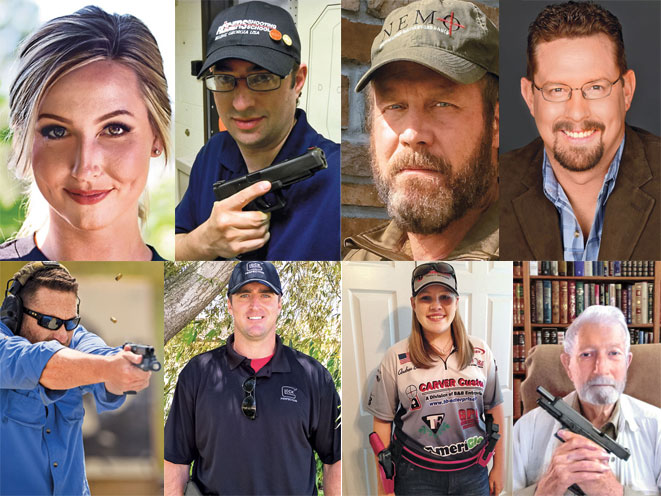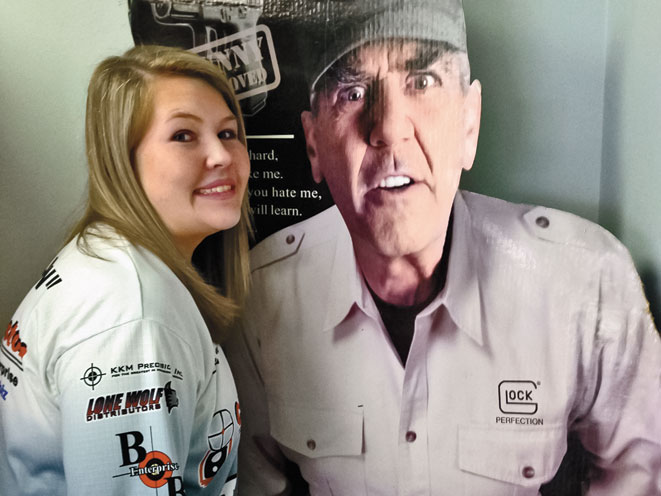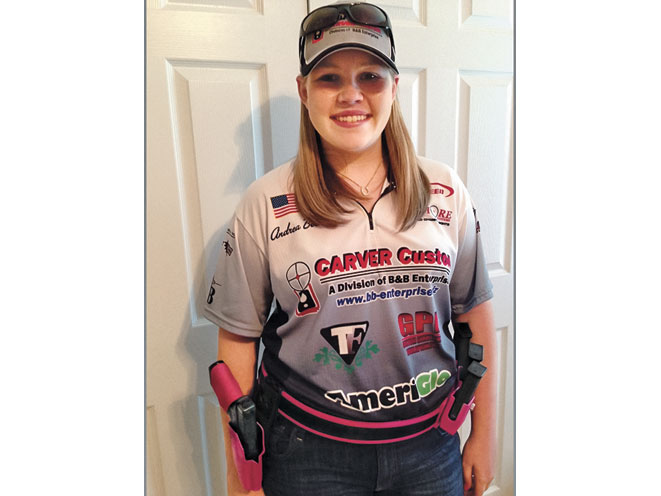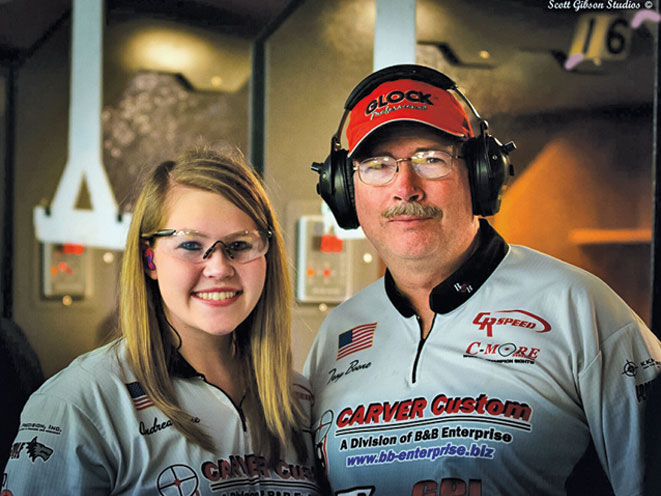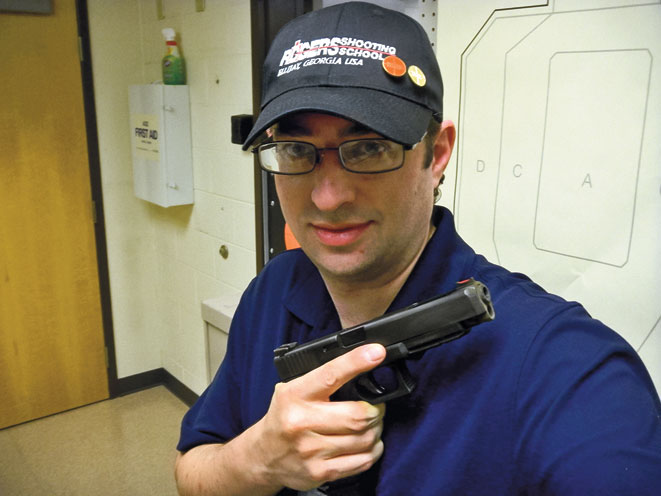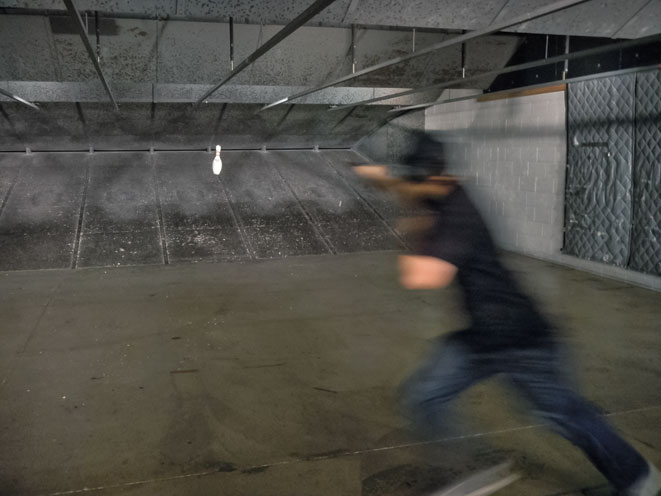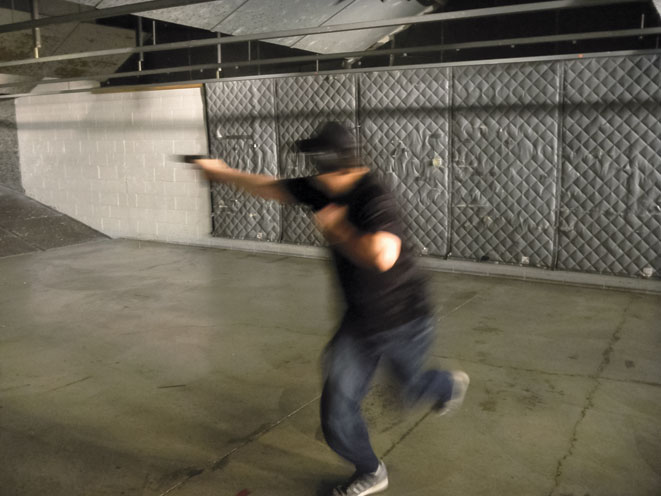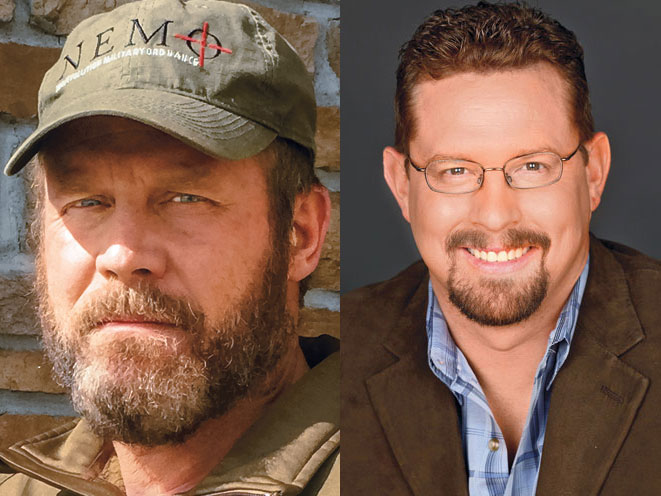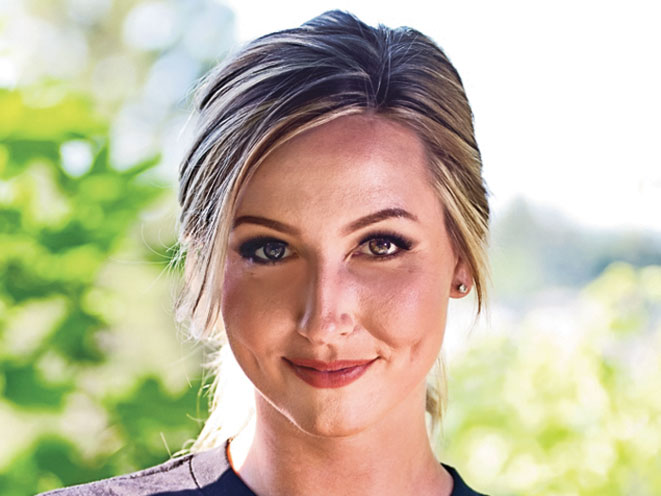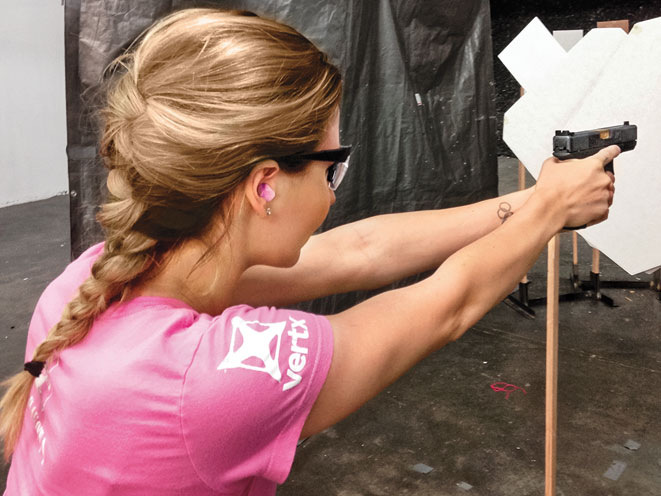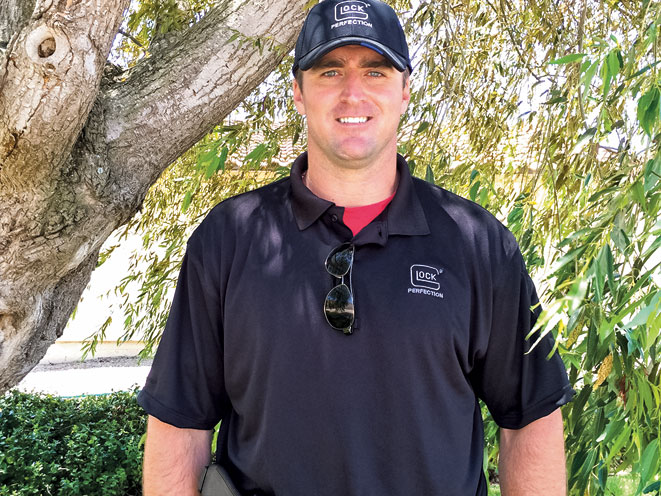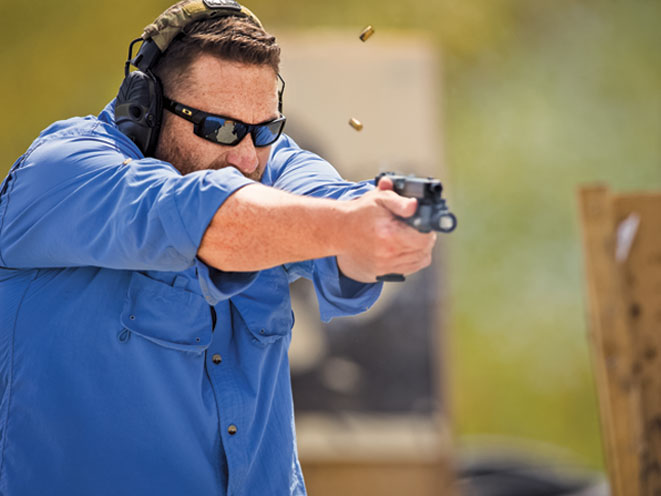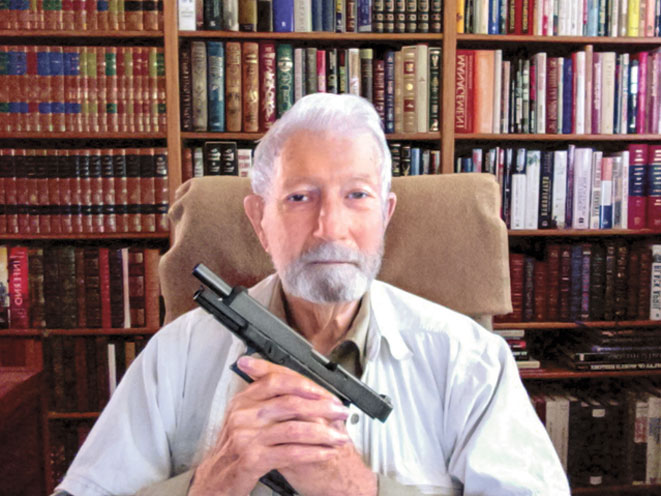The impact GLOCK pistols have had on people’s lives is nothing less than transformative. The dramatic change is not just seen in military and law enforcement circles where GLOCK pistols have completely revised the benchmark for combat pistols. Two private contractors I spoke with who were involved in the Benghazi attack on September 11, 2012, had GLOCKs as their tertiary weapons that fateful day. The effect GLOCK has had touches a broad spectrum of both men and women. From a 13-year-old competitor who picked up a GLOCK and went on to become the youngest female Master in the GLOCK Sport Shooting Foundation (GSSF) to a retired, 88-year-old USMC colonel, the range is considerable. It also includes an Olympic athlete, a world-class firearms instructor, an NFL athlete as well as an ordinary guy who picked up a GLOCK and is still one of only four persons to get a perfect score on the Rogers Shooting School Test. These are the ambassadors of GLOCK, all with different stories and experiences but united by the common thread of GLOCK pistols.
Andrea Boone

Andrea began shooting pistols at the age of 12, and started to accompany her dad, Tony, as he competed in GSSF matches. “I wanted to watch my dad compete and easily got hooked,” she said. At 13, she shot her first GSSF match in Columbia, South Carolina, and has been burning up the range ever since. By the age of 15, she was winning matches in the Amateur division.
Advertisement — Continue Reading Below
RELATED STORY: Gun Review – Glock 40 Gen4 in MOS Configuration
A 2014 match in Orlando, Florida, was a game-changer for Andrea. She came in first, it was her third win, and it propelled her to GSSF shooting stardom by making her the first ever Junior female to make Master status in the GSSF. That win was significant, as she competed against 235 shooters in that category. During the “GLOCK The Plates” event, her fastest string was 2.38 seconds.
Andrea is now 17, and her weekends are filled with shooting matches and practice. Though she has been shooting GLOCKs for only four years, she started out 2015 with five wins out of six in the Ladies Only division of GSSF. She is also working her way up to Master shooter in the Master Competition and Master Stock categories. When I asked her about how many rounds she has fired downrange since starting to compete, she laughed and started to do the math. It’s about 10,000 rounds a year.
Advertisement — Continue Reading Below
Andrea’s choice among GLOCKs is the Glock 17 Gen4. “It fits my hand perfectly, and it’s very accurate,” she said.
Gabe White

Competitors often place more emphasis on the hardware or their equipment rather than the shooting. The GLOCK pistol, however, is not distracting, allowing a competitor to get on with the shooting. “The GLOCK is an elegantly simple pistol, and when I shoot the GLOCK it is only about the shooting,” said Gabe White. “The GLOCK is a pistol that gets out of your way and let’s you concentrate on the shooting.”
Advertisement — Continue Reading Below
Prior to 2010, Gabe was a firearms trainer. He still is, but at that time he entered the world of competitive shooting and found his niche in the GSSF. It wasn’t long after the brass cooled that Gabe had won four pistols in one GSSF match: three as an Amateur and one as a Master. He ended up with four consecutive-serial-numbered GLOCK 34s, and these have become his favorite GLOCKs to use.
RELATED STORY: The Evolution of GLOCK Pistols
In fact, Gabe uses his GLOCK 34s to dominate in competition, but he also uses them for everyday carry. Yes, Gabe carries a long-slide G34 daily in the appendix position. Appendix carry allows him to wear normal clothing on a daily basis while allowing for a very fast draw from concealment when needed.
Advertisement — Continue Reading Below
Gabe ranks ninth among the FAST (Fundamentals, Accuracy & Speed Test) Challenge Coin holders with a time of 4.58 seconds. The FAST drill requires a shooter to draw a pistol loaded with two rounds from concealment, fire two rounds at a 3-by-5-inch box from 7 yards, perform a slide-lock reload and then fire four rounds at an 8-inch circle.
Gabe is also one of only four persons to get a perfect score on the Rogers Shooting School Test. The test is an orchestrated nightmare of moving plates at ranges from 7 to 21 yards fired with an unsupported left and right hand. Rob Leatham, Manny Bragg and Gabe White have managed it once. Bill Rogers, the test’s creator, has only been able to do it twice.
Mark Geist & John Tiegen
Advertisement — Continue Reading Below

The night of September 11, 2012, in Benghazi, Libya, forever bound Mark Geist and John Tiegen together as the bloody assault on the diplomatic annex unfolded, killing four Americans: U.S. Ambassador J. Christopher Stevens, U.S. Foreign Service Information Management Officer Sean Smith as well as two CIA contractors, Tyrone S. Woods and Glen Doherty. Ten others were also injured, including Geist, in the attacks that transpired over that fateful night and into the next morning.
Both Tiegen and Geist have been candid about the incident and shrug the hero labels thrust upon them. They were frank and sincere, and are both absolute fans of GLOCK pistols. Both carried GLOCKs as their secondary or tertiary weapons during and after the attack.
Mark Geist was in the Marine Corps for 12 years, then joined law enforcement before going into private contracting in 2004 in Iraq, protecting State Department personnel. During that time he carried a Glock 17, a Glock 19 or a Glock G26—all 9×19 GLOCKs. He was a firearms instructor in the Marines and trained tactical teams in Iraq. During the Benghazi incident, he was injured in the mortar attack that killed the CIA’s Woods and Doherty.
Advertisement — Continue Reading Below
RELATED STORY: GLOCKimonials – 7 Stories Where A GLOCK Pistol Saved The Day
Geist became a real GLOCK advocate when he started carrying them overseas. As an instructor, he wanted to test the reliability of the GLOCK and ran one for 10,000 rounds, over a 90-day period, without cleaning or lubing it. The GLOCK still kept shooting.
“GLOCKs are always reliable in every aspect that I use them,” Geist explained. He likes the GLOCK 19 but prefers the new 9×19 GLOCK 43 for a secondary or backup weapon due to its ability to be easily concealed.
Advertisement — Continue Reading Below
The first time John Tiegen fired a GLOCK was in 2003 when he was qualifying for a security contract position in Kuwait. It was the first time he’d ever fired a pistol, and he qualified with a Glock 19. Tiegen joined the Marines in 1995. “Even though I was in the Marine Corps,” Tiegen said with a smirk, “we didn’t have pistols.”
On the night of the Benghazi attack, however, Tiegen had a GLOCK 17 pistol along with a SAW machine gun and an M4 Carbine. Typically a GLOCK was his second or even primary weapon system as a security contractor depending on his mission or assignment.
“Luckily I didn’t have to draw the GLOCK that night,” said Teigen. “But I knew it was there and I could rely on it.”
Advertisement — Continue Reading Below
Tiegen has used 9×19 GLOCK 17 and GLOCK 19 pistols exclusively while serving as a security contractor overseas. Because his hands are larger than average, he likes the GLOCK 17 in particular and uses it regularly as his concealed-carry weapon of choice.
Amanda Furrer

At the age of 11, Amanda Furrer became a member of the Spokane Junior Rifle Team. By 2007, she’d qualified for the U.S. national team and went on to compete in the 2012 Olympic Games in London, where she placed 15th in the world. Her eye is now on Rio de Janeiro and the 2016 Olympic Games in Brazil. Her regular routine these days at the Olympic Training Center in Colorado consists of workouts and shooting practice.
Currently, she ranks among the best small-bore rifle shooters in the U.S. She knows firearms but did not handle a pistol until later in her career, and the first pistol she used was a GLOCK. Her dad is a military veteran who competes in matches.
RELATED STORY: 8 Night Sights, Lights and Lasers For The GLOCK 43
“My dad has a bit of a GLOCK obsession. I think he has every single GLOCK model and generation ever made,” Amanda said. Her dad gave her a 9×19 GLOCK 19 as a graduation gift.
“Going to college and living on my own for the first time,” said Amanda, “my GLOCK became the tool that I relied on for personal protection. My GLOCK provided me with the confidence I needed to move across the country by myself. GLOCK has continued to be my first choice for personal protection and has allowed me to be a self-reliant woman.”
Amanda has a growing collection of GLOCKs herself. She particularly likes the G43. “As a female, the size of the G43 makes it easily concealable on my body,” Amanda explained. “I prefer to carry on my body rather than in a bag, and the G43 makes that very possible in almost anything I wear because of its small frame.”
Amanda plays the country-western singer in the new G43 commercial, and she is also involved in two organizations: Boot Campaign and Brat Pack 11. She likes to do as much as possible with foundations and charities that support our troops. “It’s something that hits close to home,” she explained, “and I’m so thankful for the men and women that protect the country that I love.”
“Bear” Pascoe

As a tight end at Fresno State in 2007 against Texas A&M, McKenna Sean “Bear” Pascoe tied the record for the most touchdown receptions. It wasn’t surprising that the NFL was interested in his talents. As a member of the New York Giants, Bear caught his first career touchdown in the 2011-2012 season during the NFC Championship game against the San Francisco 49ers. The Giants would go on to win Super Bowl XLVI. There was no doubt as I spoke with Bear that he is a champion through and through, and he prefers GLOCK pistols.
Bear grew up in California on a big cattle ranch and was—and still is—a real cowboy. He learned to cowboy and ride and rope at an early age. He followed in his dad’s footsteps and received a scholarship at Fresno State. Part of his upbringing included hunting, so Pascoe was around guns his entire life, mostly rifles and shotguns. He never really fired pistols much in the past but was interested in them, and a few years ago became acquainted with GLOCKs.
RELATED STORY: Massad Ayoob – You Got A GLOCK. Now What?
At an event sponsored by American 300, a non-profit dedicated to volunteerism and increasing the resiliency of our service members, their families and their communities, Bear was taught proper pistol handling, including all of the fundamentals. As Bear mentioned, he is still learning and training with pistols, but it was GLOCK that really opened the door to him for pistol shooting. “GLOCKs are all-around good guns that are simple to understand and shoot well,” said Bear.
His GLOCK of choice is the G21 in .45 AUTO. “The G21 fits me,” said Bear. “I don’t have huge hands, but I do have skinny fingers—better to catch footballs—and the G21 fits me right.”
Michael Lamb

Mike Lamb is a U.S. Marine and has trained over 7,000 special operations, federal and local law enforcement personnel. Currently, he operates Stoic Ventures, a training and consulting firm composed of former military and law enforcement personnel who offer expertise in operations, strategy, organization, technology and security. “Stoic is from the the Greek philosophy,” explains Lamb. “I saw a lot of guys not make it through combat because emotions took over instead of logic.” Fear and anger are emotions one tries to eliminate. A Marine understands the meaning of being stoic and under dynamic stress, such as in combat or a deadly confrontation, logic or the act of being stoic enables students to cope. GLOCK pistols play a big part in that training.
“The GLOCK platform is friendly for gross motor skill movement and is such a simple weapon to operate,” said Lamb. He had run 1911s a lot, but he quickly moved past the preconceived notions about what a weapon should or should not be. Lamb hasn’t looked back since. “The platform is uncomplicated and simple.” According to Lamb, this simplicity reduces training time when compared to other pistols. “With a simple user interface, the GLOCK is a go-to weapon.” Lamb often demonstrates his GLOCK’s accuracy to non-believers by hitting steel out to 200 yards.
Colonel Williamson

Most who know him simply refer to Tren Williamson as simply “Colonel.” He spent most of his life in the U.S. armed forces, starting in 1950. Williamson was a midshipman with the Naval ROTC program at the University of Washington before being physically disqualified. Then he enlisted in the Marine Corps and never looked back.
The Colonel had a deep desire to serve his country. He served in Korea from 1965 to 1966, and as a company commander of the 27th Marine Regiment in 1968 during the Tet Offensive. In 1989, he retired from the Marine Corps as a colonel. During his time in the Corps, the Colonel was an active competitive shooter and spent time competing internationally for several military shooting teams.
RELATED STORY: GLOCK – The First Name In Safety
“I had always used the 1911 in competition and combat,” explained Williamson. When he retired, the Colonel took up civilian competitive shooting. On moving to Sequim, Washington, the NRA’s conventional 50- and 25-yard course of fire was not conveniently available, so he became involved in the International Defensive Pistol Association (IDPA). “The 1911 did not, in my estimation, meet the requirements of the IDPA program,” said Williamson. “However, the GLOCK pistol, again in my estimation, was absolutely perfect for the job.”
Williamson’s favorite GLOCK is the Glock 17. “With the advent of quality ammunition in 9×19, that round has become extremely proficient at putting an intruder down for the count. I keep a Glock 17 Gen4 equipped with a green laser ready for engagement if required.” Additionally, he has nine other GLOCK pistols, the most of any pistol or revolver in his collection.
When asked what it is he likes about GLOCK pistols, he responded directly. “First, the trigger press is always the same, never a variation, period. Secondly, the frame has a degree of flex, which, with the heavier calibers, softens the recoil somewhat. Thirdly, maintenance is minimal. You can run a GLOCK many a mile without problems. Fourth, with the wide range of GLOCK models, one can accommodate most any situation with no difficulty whatsoever.”
Now in his mid-80s, he is one of the oldest GSSF competitors. He’s a legend among shooters in the Pacific Northwest. And even though he has an impressive firearms collection, Colonel Williamson prefers to shoot and carry a GLOCK.
